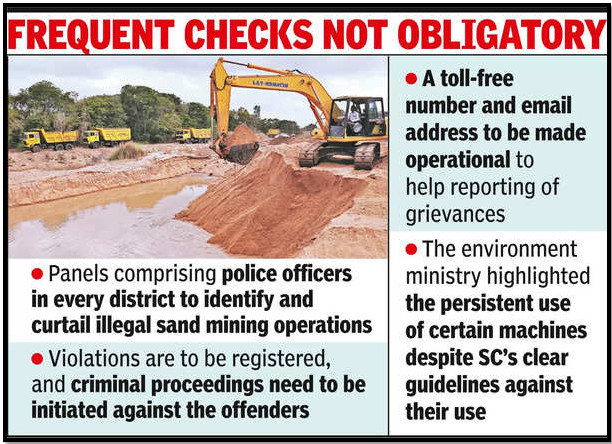“TACKLING ILLEGAL MINING IN SARISKA: A LONG ROAD AHEAD”
Syllabus:
GS-3 : Environmental issues such as sand mining and its impact on environment and other sectors of economy
Focus :
- The article focuses on the persistent issue of illegal mining in and around the Sariska Tiger Reserve, detailing the decades-long judicial and administrative efforts to halt these activities.
- It highlights the challenges posed by ambiguous reserve boundaries, the impact on local communities, and recent Supreme Court orders aimed at enforcing stricter protections for the reserve.
Introduction
- Illegal mining in and around the Sariska Tiger Reserve has been a persistent issue for decades.
- Despite numerous efforts by the Supreme Court (SC) and other bodies to halt these activities, challenges such as ambiguous reserve boundaries have thwarted progress.
- This article explores the history of illegal mining in Sariska, the judicial interventions, and the ongoing struggle to protect this vital habitat.
Historical Context
- Early Concerns: Illegal mining in Sariska has been an issue since the 1970s, with activities largely focused on marble extraction.
- Legislation: The Wildlife Protection Act, 1972, and the Environment Protection Act, 1986, both prohibit quarrying in protected areas.
- Initial SC Involvement: In 1991, the Supreme Court took up the issue, aiming to curb illegal mining activities that were degrading the habitat.
- First Major Orders: In 2001, in response to a Public Interest Litigation (PIL) by a local NGO, the SC issued an interim order to stop all mining operations within Sariska’s protected areas.
- Formation of Committees: The SC set up a fact-finding committee under Justice M.L. Jain to investigate and report on the extent of illegal mining activities.
Source- ToI
Judicial Interventions
- 2005 SC Order: Following the disappearance of tigers from Sariska, the SC ordered the closure of all mining activities in the core area of the reserve.
- Critical Reports: The Central Empowered Committee (CEC) reports in the mid-2000s highlighted continued illegal mining despite SC orders.
- Temporary Measures: In 2005, the SC allowed temporary mining permits for measures outside the immediate sanctuary zone but insisted on maintaining a safety buffer.
- Renewed Mining: By 2008, mines resumed operations under claims by the Rajasthan government that they were outside the 100-meter periphery of the sanctuary.
- 2011 Draft Notification: Efforts to establish an Eco-Sensitive Zone (ESZ) around Sariska faced delays, with boundary demarcations proving contentious.
Eco-sensitive Zone :
Activities Focus :
|
Boundary Discrepancies
- Conflicting Records: In 2003, discrepancies between the Forest Department’s records and maps submitted to the SC caused significant confusion.
- Survey Challenges: The Sariska authorities attempted to reconcile these differences with the Survey of India, but the endeavor was hampered by missing documents and conflicting claims.
- 2006 Order: The SC intervened again, warning state governments to delineate ESZs or face the imposition of a 10-km wide buffer.
- State Responses: Many states, including Rajasthan, struggled to respond appropriately, leading to further judicial directives.
- 2022 SC Order: A minimum width of 1 km for ESZs around national parks and sanctuaries was mandated, with Sariska’s boundaries still under scrutiny.
Impact on Local Communities
- Village Protests: Local communities have repeatedly protested against the unclear boundaries, which they argue allow illegal miners to exploit the land.
- Economic Impact: Villagers claim that illegal mining disrupts their livelihoods and leads to environmental degradation.
- Corruption Allegations: Reports of officials issuing No Objection Certificates (NOCs) to miners exacerbate the problem.
- Compensation Issues: Proposals to compensate for illegal mining by adding revenue land to the reserve have seen mixed results.
- Community Involvement: Calls for more inclusive and transparent processes in demarcating and managing reserve boundaries have been persistent.
Recent Developments
- May 2023 Order: The SC clarified that its orders against mining within a 1-km radius of reserves like Sariska remain in effect.
- Renewed Enforcement: Rajasthan government has been tasked with strict enforcement of these orders, emphasizing no mining in the critical tiger habitat (CTH).
- Survey of India Collaboration: Efforts to create reliable and updated maps of the reserve are ongoing, with the Survey of India playing a crucial role.
- Conservation Plans: The Sariska Tiger Conservation Plan, which has faced delays, is crucial for the long-term management and protection of the reserve.
- Official Statements: Rajasthan Forest Department officials have expressed optimism that recent orders will provide a fresh impetus to address the illegal mining issue comprehensively.
Conclusion
- Illegal mining in Sariska continues to be a significant challenge despite decades of judicial and administrative efforts.
- The persistent ambiguity around the reserve’s boundaries has allowed illegal activities to flourish.
- However, the recent SC orders provide another opportunity to enforce protections more effectively.
Source:The Hindu
Associated article :
https://universalinstitutions.com/27304-2/
Mains Practice Question :
GS-3
“Discuss the persistent issue of illegal mining in and around the Sariska Tiger Reserve. Highlight the historical context, judicial interventions, boundary discrepancies, impact on local communities, and recent developments. What measures can be taken to effectively address these challenges and ensure the long-term protection of the reserve? (250 words)”




